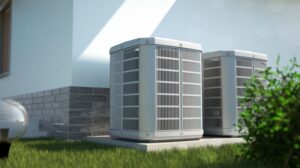 If you know the basics about heat pumps, then you can probably explain one of the big differences between a heat pump and an air conditioner right away: a heat pump works as both a cooling system and a heating system, where an air conditioner only cools.
If you know the basics about heat pumps, then you can probably explain one of the big differences between a heat pump and an air conditioner right away: a heat pump works as both a cooling system and a heating system, where an air conditioner only cools.
However, air conditioners and heat pumps are similar in many ways. They both use refrigerant to work, condensing and evaporating it in two sets of coils, and they have similar components (compressor, blower fan, exhaust fan, condensate drainage) and similar configurations (an interior air handler and exterior cabinet). Outwardly, it’s difficult to tell the difference between them. But there obviously are differences—because a heat pump does two jobs where an AC does one.
So what makes an AC and heat pump different? We’ll take a closer look below.
Heat pumps can change the direction refrigerant flows
This is the big difference that separates a heat pump from an air conditioner. Refrigerant is the heat transfer medium that allows an AC and heat pump to absorb heat from one set of coils and release it in the other. In an air conditioner, refrigerant only moves in one direction: it leaves the compressor as a hot gas and travels to the outside coils, where the refrigerant condenses and releases heat outdoors. The refrigerant then moves indoors, passing through a pressure relief valve that causes its temperature to drop further and turn into a cold liquid. This liquid moves through the indoor coil where it absorbs heat and cools the air. It then returns to the condenser.
Now imagine what happens if this process runs in reverse. The hot refrigerant would move first indoors and release heat from the coil, putting heat into the indoor air. The refrigerant would then move outdoors, changing into a cold liquid and absorbing heat through the outdoor coil before returning to the compressor. Essentially, switching the direction refrigerant moves causes the two sets of coils to swap jobs.
The key component necessary for a heat pump to change the direction of refrigerant flow is the reversing valve. This valve is located on the refrigerant line leaving the compressor, and depending on how it’s set it will send the refrigerant either to the outdoor coil (cooling mode) or indoor coil (heating mode).
Other important differences
There are several other differences in heat pump and AC construction. During winter, a heat pump’s exterior coil will collect frost because of the water moisture that collects along its surface during evaporation. To remedy this, a heat pump has defrost controls. Periodically, the heat pump will change the direction of refrigerant flow so the coils give off heat and melt off the frost. It will then go back to normal heating mode.
A heat pump uses less refrigerant in heating mode. To store the excess refrigerant, a heat pump has a part called the suction line accumulator. This also helps to prevent cold refrigerant from flowing backward into the compressor (slugging), which can cause the compressor to break.
If you have any questions about heat pumps in Colorado Springs, CO, ask us!
Robbins Heating & Air Conditioning serves Colorado Springs and the surrounding area. Call us for heat pump service—installation, repair, replacement, maintenance.
